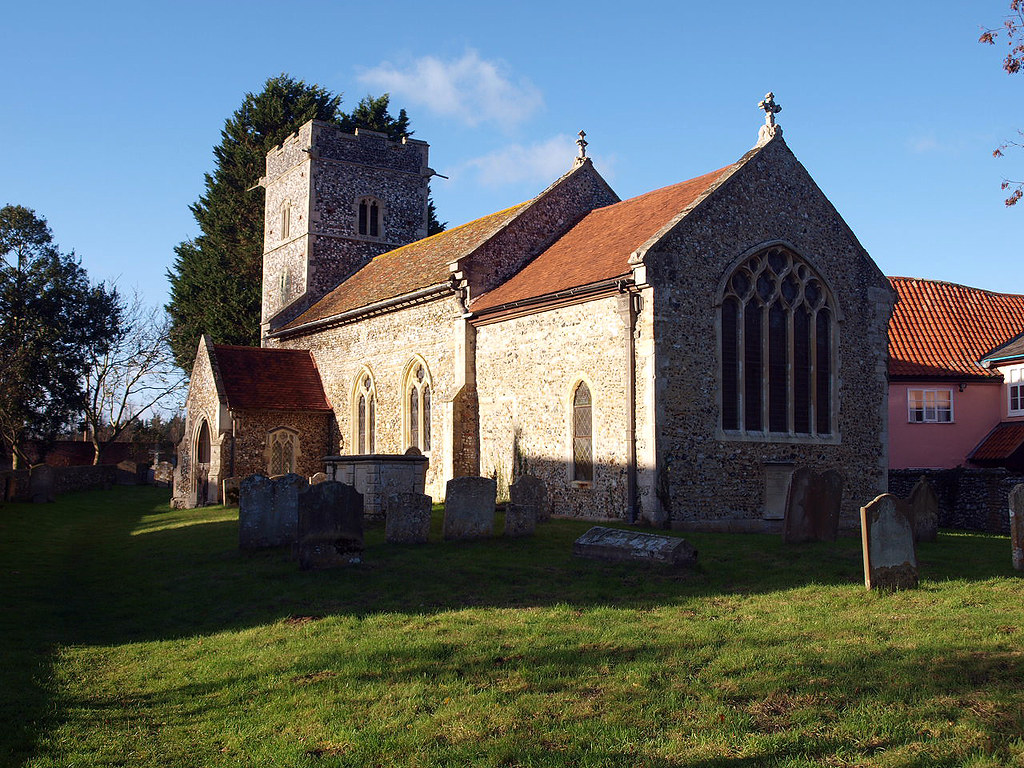I revisited [Mar 2019] and found the keyholder and can confirm this is a wonderous interior.
ST PETER. Nave and chancel and W tower. Much restored by Teulon about 1848. The only interesting part is the N chantry chapel, built, according to its inscription, as a Capella Perpetue Cantarie Johis Coket. The foundation was granted in 1479. Four-centred arch from the church with cresting over. The arch is panelled inside. Nice boarded chancel roof with painted bosses, etc., re-discovered in 1889. - COMMUNION RAIL. Late C18. - PLATE. Paten 1631; Cup 1637; Flagon 1639; Almsdish 1714. - MONUMENTS. Brasses probably of Cokets: kneeling Civilian and Wife, c. 1480 (18 in.); Lady of c. 1480 (17 in.); Lady c. 1490 (12 in.; palimpsest of portion of a lady of c. 1460); two Sons (only 6 in.) c. 1490. All nave floor, except the Lady of c. 1490. This brass is on the N wall of the nave. - William Whettell d. 1628 by Nicholas Stone. Rather flatly modelled frontal bust in an arched niche. Good. - Sir Henry Calthorpe, by John and Matthias Christmas, 1638. Two frontal demi-figures holding hands; in a circular niche. Small figures of children in the ‘predella’ below. Two columns support an open segmental pediment. - Dorothy Calthorpe d. 1693. Kneeling figure in an arched niche, a conservative motif. - James Calthorpe d. 1784. Oval medallion with head in profile, before an obelisk. Attributed to Bacon in Suff. Arch. Soc. vol. I, but not signed.
AMPTON. A lovely village along a quiet road, it is best approached from Ingham by a way through wonderful pine woods where it is dark at noonday. The hall stands in nearly 700 acres of woods and meadows, and has a splendid lake; in its park, among many other fine trees, are Chilean pines, cedars of Lebanon, cork trees, and tulip trees. The great house itself is modern, but its predecessor was the birthplace of Ampton’s famous man, Admiral Fitzroy, one of our pioneer meteorologists. He was born in Trafalgar year in the home of the Calthorpes, and entered the Navy at 14. He was on the famous voyage of the Beagle in which Darwin started his career, and he became interested in forecasting the weather, beginning the first official forecasts in 1861.
There is much to remind us of the Calthorpes in the little 15th century church. A massive marble monument shows Henry Calthorpe of 1536 holding hands with his wife while their sons and daughters kneel below; and near by is a marble bust of Sir Henry of 1628 in his fur-collared robe and ruff. An 18th century tablet shows the profile of James Calthorpe, and an elaborate monument shows Dorothy who founded the charming almshouses in 1693. We see her at prayer, and her inscription begs us to let her rest::
I troubled no man's dust; let others be to me as just.
I troubled no man's dust; let others be to me as just.
The chancel has a painted roof, part of which is Jacobean, and an attractive east window of Christ and four saints, Peter, Paul, Edmund, and Ethelred. The chantry was built at the beginning of the Tudor Age by John Coket, and has a fine arch with modern mosaics at the sides, one of St Christopher and one of St George. In the nave are three 15th century brasses with figures of a man, two women, and six children, all unknown; on the wall is an inscription to Jeremy Collier, rector here from 1679 to 1684, historian of the Church and a great controversalist. Macaulay said, “he was, in the full force of the words, a good man.” ‘The rare treasure of the church is its “Sealed Book,” of which neither the British Museum nor the Bodleian has a copy. It is a revised Prayer Book of 1661, with a signed and sealed certificate at the end to prove that it had been examined and found to be a perfect copy of the original parchment Prayer Book attached in 1662 to the Act of Uniformity and called The Book Annexed.
The churchyard has some very old tombstones, one near the porch being to William Sakings of 1689, who during his 78 years was in the service of three Stuart kings. The lovely rectory has a walled garden with a charming cottage and a riotous profusion of flowers.

No comments:
Post a Comment